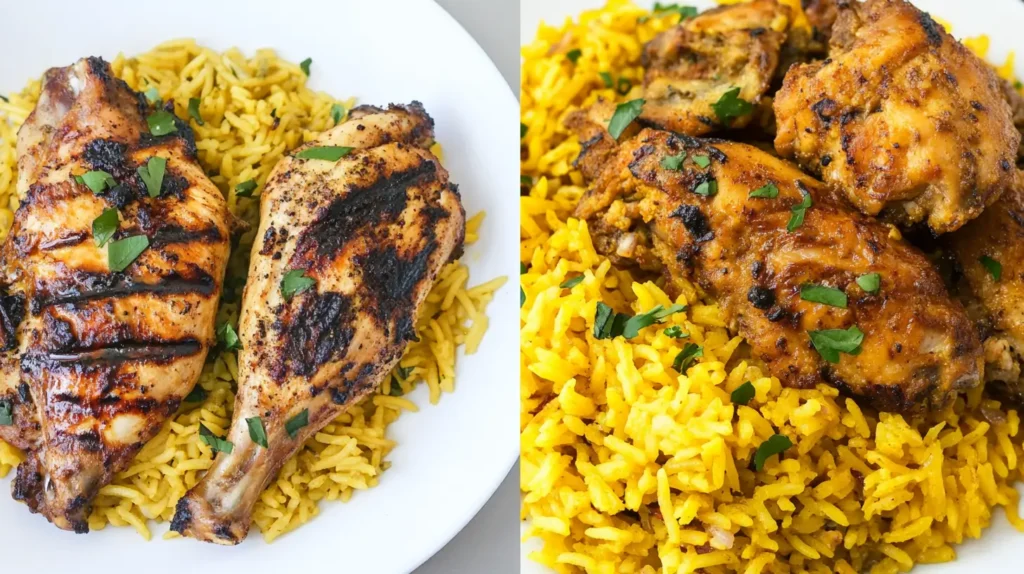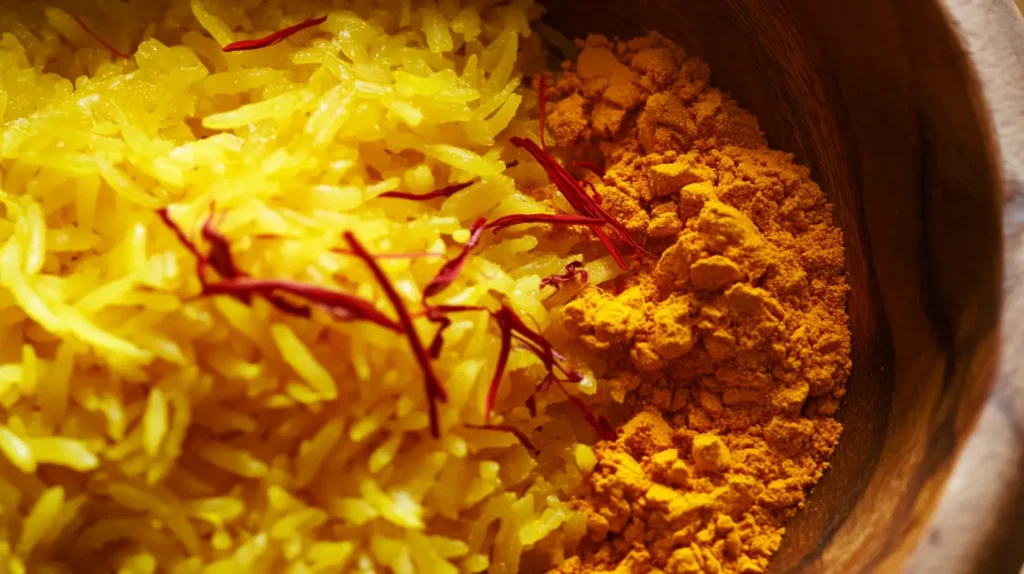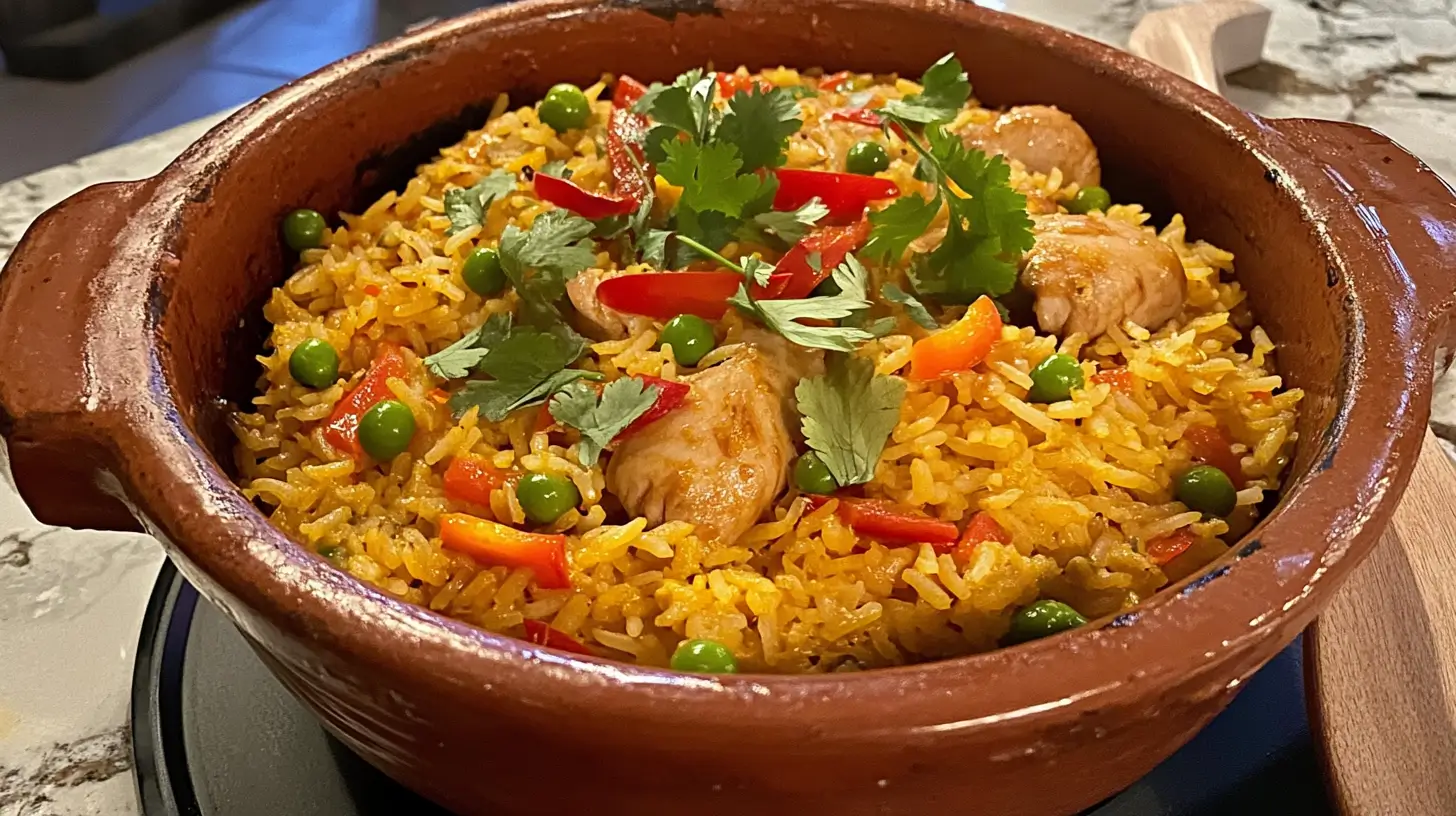Introduction
Yellow rice and chicken is a popular dish in various cuisines, from Spanish and Caribbean to South Asian and Middle Eastern. But with health-conscious eating on the rise, many people are asking: Is yellow rice and chicken healthy?
The answer isn’t as simple as a “yes” or “no.” The healthiness of this meal depends on factors like ingredients, preparation methods, and portion sizes. Yellow rice gets its signature color from spices like turmeric or saffron, which offer health benefits, but it’s also high in carbohydrates. Chicken, on the other hand, is an excellent source of protein, but how it’s cooked makes a difference in its nutritional value.
In this article, we’ll break down the nutritional value, benefits, and potential downsides of yellow rice and chicken. We’ll also compare it to other rice types, discuss healthier preparation methods, and answer frequently asked questions about this beloved dish.
Table of Contents
Introduction to Yellow Rice and Chicken
What is Yellow Rice?
Yellow rice is simply white rice colored and flavored with spices like turmeric, saffron, or annatto. While these ingredients add a rich, golden hue and a mild, aromatic taste, they also contribute anti-inflammatory and antioxidant properties. In many cultures, yellow rice is a staple side dish that pairs well with proteins like chicken, beef, or seafood.
However, not all yellow rice is created equal. Some pre-packaged versions use artificial colorants and high sodium content, which can diminish its nutritional value. Homemade versions, made with natural spices and brown rice, tend to be the healthier choice.
The Origins and Popularity of Chicken and Yellow Rice
The combination of chicken and yellow rice is deeply rooted in Spanish, Latin American, and South Asian cuisine. In Spain, the dish is closely related to paella, while in the Caribbean, it’s a comfort meal often cooked in one pot with vegetables and spices. Indian and Middle Eastern variations use saffron and a blend of warm spices to enhance the flavor.
This dish is widely loved because it’s:
Affordable and easy to prepare
Packed with flavor and nutrients
A balanced meal with protein, carbs, and fiber
Whether served as a quick dinner or a festive dish for gatherings, chicken and yellow rice remains a hearty, delicious, and satisfying meal enjoyed worldwide.
Why People Consider It a Healthy Meal Option
Many believe yellow rice and chicken is a healthy meal because it provides a balance of protein, carbohydrates, and essential vitamins. Chicken is lean and high in protein, while yellow rice can be a good source of energy. The spices used in yellow rice, like turmeric, offer health benefits that aid digestion and reduce inflammation.
However, the healthiness of this dish depends on factors like:Rice type – Brown rice is healthier than white rice.Cooking method – Grilled or baked chicken is better than fried.Ingredients used – Homemade versions are often more nutritious than pre-packaged or restaurant-made options.
So, is yellow rice and chicken healthy? It can be—but only if you prepare it the right way! In the next section, we’ll take a closer look at its nutritional breakdown to see how it truly stacks up.
Nutritional Breakdown of Yellow Rice and Chicken
Macronutrients: Carbohydrates, Proteins, and Fats

One of the most important factors in determining is yellow rice and chicken healthy? is its macronutrient content. This dish is a combination of carbohydrates from the rice, protein from the chicken, and small amounts of fat depending on the cooking method.
- Carbohydrates: Yellow rice, whether made from white or brown rice, is carb-dense, with about 45-50g of carbs per cup. Brown rice is the better choice for those looking for a higher fiber content and a lower glycemic index.
- Protein: Chicken provides a high-quality protein source, with one serving (3.5 ounces) containing about 27g of protein. Protein is essential for muscle repair, immune function, and satiety.
- Fats: The fat content depends on how the dish is prepared. Skinless, grilled, or baked chicken keeps fat levels lower, while frying can add unhealthy saturated fats.
Vitamin and Mineral Content
Aside from macronutrients, yellow rice and chicken can offer essential vitamins and minerals, especially when prepared with wholesome ingredients.
- Turmeric & saffron: These spices contain antioxidants and anti-inflammatory compounds like curcumin, which may help reduce inflammation and support brain health.
- B vitamins: Chicken and rice provide niacin, riboflavin, and B6, which help convert food into energy and support nervous system function.
- Iron & zinc: Chicken is rich in iron, necessary for oxygen transport, and zinc, which helps with immunity.
Caloric Content: How Many Calories Does It Contain?
The total calorie count in yellow rice and chicken varies based on ingredients and portion sizes. On average:
- 1 cup of yellow rice: ~200–250 calories
- 3.5 ounces of skinless chicken breast: ~165 calories
- 1 tablespoon of oil/butter (if used): ~120 calories
A single serving can range between 400–700 calories, making it a filling meal. However, adding extra oils, butter, or fried chicken can significantly increase the calorie count.
To keep it healthy, opt for grilled chicken, minimal oil, and brown rice instead of white rice.
The Health Benefits of Yellow Rice and Chicken
Anti-Inflammatory Benefits of Turmeric in Yellow Rice
One of the standout ingredients in yellow rice is turmeric, a powerful anti-inflammatory spice. The active compound in turmeric, curcumin, has been linked to:
Reducing inflammation – May help with conditions like arthritis.
Boosting brain health – May lower the risk of neurodegenerative diseases.
Supporting digestion – Helps stimulate bile production and gut health.
Saffron, another spice used in some yellow rice recipes, is also packed with antioxidants that may improve mood and reduce oxidative stress.
Protein Benefits from Chicken for Muscle Health
Chicken is a complete protein source, meaning it contains all essential amino acids. Here’s why it’s good for you:
Supports muscle repair and growth – Ideal for active individuals and athletes.
Keeps you full longer – Protein promotes satiety, helping with weight management.
Aids in metabolism – The amino acids help maintain lean muscle mass, which burns more calories at rest.
Rich in Essential B Vitamins and Minerals
Together, yellow rice and chicken provide a good balance of B vitamins and minerals that play key roles in:
Energy production – B vitamins help convert food into usable energy.
Red blood cell formation – Iron from chicken supports oxygen transport in the body.
Immune health – Zinc strengthens the immune system and aids in wound healing.
But is yellow rice and chicken healthy for daily consumption? While it offers important nutrients, it’s best eaten in moderation, especially if using white rice. Choosing brown rice and lean chicken cuts can enhance its health benefits.
For a delicious and nutritious recipe, check out this healthy chicken and yellow rice recipe.
Potential Health Concerns of Yellow Rice and Chicken
High Carbohydrate Content and Its Impact on Blood Sugar
One of the biggest concerns about yellow rice and chicken is its high carbohydrate content. White rice, which is often used in yellow rice recipes, has a high glycemic index (GI), meaning it can cause a quick spike in blood sugar levels.
For individuals with diabetes or insulin resistance, this can be problematic as it may lead to:
Increased blood sugar fluctuations
Higher risk of weight gain due to excess carbs
Potential energy crashes after meals
Solution? Switching to brown rice or quinoa instead of white rice can help stabilize blood sugar and provide more fiber and nutrients.
Sodium and Preservatives in Pre-Packaged Yellow Rice Mixes
If you’re using store-bought yellow rice mixes, they may contain high levels of sodium and artificial preservatives. Many brands use flavor enhancers, MSG, and artificial colors to mimic the rich taste of homemade yellow rice.
High sodium intake has been linked to:
High blood pressure
Water retention and bloating
Increased risk of heart disease
Solution? Making homemade yellow rice with natural spices like turmeric and saffron allows you to control the salt content and avoid unnecessary additives.
Fat Content and Cooking Methods That Affect Health
The way you prepare chicken and yellow rice can dramatically affect how healthy it is. Fried or heavily buttered chicken adds unhealthy saturated fats, which may contribute to:
Higher cholesterol levels
Increased heart disease risk
Extra, unnecessary calories
Solution? Opt for grilled, baked, or air-fried chicken instead of deep-fried. If you want to add richness, use healthier fats like olive oil instead of butter or processed oils.
Is Yellow Rice a Healthy Choice Compared to Other Rice Types?
Yellow Rice vs. White Rice: Which is Healthier?
Many people wonder, Is yellow rice and chicken healthy when compared to plain white rice? The truth is, yellow rice is essentially white rice with added spices, meaning it has a similar carb and calorie content. However, if prepared with natural ingredients, yellow rice may offer:
More antioxidants from turmeric and saffron
Potential anti-inflammatory benefits
A slightly richer flavor without added fat
But since it’s still a refined grain, yellow rice doesn’t offer as much fiber or sustained energy as whole-grain options.
Yellow Rice vs. Brown Rice: Nutritional Differences
Brown rice is the clear winner when it comes to nutrition. Here’s why:
- Higher fiber content – Helps with digestion and blood sugar control.
- More vitamins and minerals – Retains B vitamins and magnesium lost in white rice processing.
- Lower glycemic index – Better for diabetics and those watching their blood sugar.
If you’re looking for a healthier alternative, making yellow rice with brown rice instead of white is a great option.
Is Golden Rice the Same as Yellow Rice?
A common misconception is that golden rice and yellow rice are the same, but they are actually quite different.
Golden rice is a genetically modified rice designed to contain vitamin A (beta-carotene) to combat deficiencies in developing countries. Yellow rice, on the other hand, is simply white or brown rice flavored with spices like turmeric and saffron.
If you’re looking for a healthier choice, stick to homemade yellow rice with natural ingredients and whole grains.
How to Make Chicken and Yellow Rice Healthier
Choosing Whole-Grain or Brown Rice Alternatives

If you love yellow rice but want a healthier version, switching to brown rice or quinoa is a great move. These whole grains contain more fiber, vitamins, and minerals, helping with digestion and keeping you full longer.
Brown rice – Provides more fiber and nutrients than white rice, keeping blood sugar levels steady.
Quinoa – A high-protein alternative that’s also gluten-free and rich in essential amino acids.
Cauliflower rice – A low-carb substitute for those watching their carb intake.
By making this simple swap, you’ll turn a carb-heavy dish into a nutrient-rich meal without sacrificing taste.
Using Fresh Spices Instead of Packaged Seasoning Mixes
Many store-bought yellow rice mixes contain artificial flavors, preservatives, and excessive sodium. Instead, use natural spices like:
- Turmeric – Adds color and provides anti-inflammatory benefits.
- Saffron – A natural antioxidant that enhances flavor and aroma.
- Garlic and onion powder – Adds depth without extra salt.
Making your own seasoning blend gives you full control over the ingredients, ensuring your yellow rice stays flavorful yet healthy.
Healthier Cooking Methods: Grilled vs. Fried Chicken

How you cook your chicken significantly impacts whether yellow rice and chicken is healthy or not.
Best cooking methods:
Grilled chicken – Low in fat and high in protein.
Baked chicken – Retains moisture without extra oil.
Air-fried chicken – Crispy texture with less oil than deep frying.
Avoid: Deep-fried chicken or heavy butter-based sauces, as they add unnecessary fats and calories.
By choosing the right cooking method, you can enjoy chicken and yellow rice as a nutritious and balanced meal without feeling guilty!
Delicious and Healthy Variations of Yellow Rice and Chicken
Spanish-Style Chicken and Yellow Rice

Spanish-style yellow rice and chicken is a flavor-packed meal often cooked with tomatoes, bell peppers, and smoked paprika. It’s a one-pot dish that brings together bold flavors without needing heavy oils or creams.
Swap white rice for brown rice for added fiber.
Use lean chicken breast instead of thighs for less fat.
Add veggies like peas and carrots for extra nutrients.
This version is not only delicious but also better for heart health and digestion.
Vegetable-Loaded Yellow Rice and Chicken for More Fiber
Adding vegetables to your yellow rice makes it healthier and more filling. Some great options include:
- Spinach and kale – Packed with iron and vitamins.
- Carrots and bell peppers – High in fiber and antioxidants.
- Mushrooms and zucchini – Add texture and a low-calorie boost.
Vegetable-loaded yellow rice balances out the carbs while making the dish more colorful and nutritious.
Low-Calorie, High-Protein Variants
If you want to lower the calorie count but still keep the protein high, try:
Using cauliflower rice instead of regular rice
Cooking with skinless, grilled chicken breast
Adding beans or lentils for extra plant-based protein
This variation makes yellow rice and chicken a great meal for weight management and muscle building.
FAQs – Common Questions About Yellow Rice and Chicken
What Pairs Well with Yellow Rice?
Yellow rice is a versatile side dish that pairs well with many foods. To make your meal more balanced and nutritious, consider adding:
Lean proteins – Grilled chicken, shrimp, or tofu complement yellow rice perfectly.
egetables – Roasted bell peppers, steamed broccoli, or sautéed spinach add fiber and vitamins.
Legumes – Black beans or chickpeas boost protein and provide slow-digesting carbs.
A well-rounded meal will enhance the dish’s nutritional value while keeping it flavorful and satisfying.
What Can I Add to Chicken and Rice to Make It Less Dry?
If your chicken and yellow rice turn out dry, don’t worry—there are easy fixes to keep the dish moist and flavorful:
Use a broth-based cooking method – Cooking rice with chicken broth instead of water adds flavor and moisture.
Add a sauce – A drizzle of lemon garlic sauce or yogurt-based dressing can make the dish juicier and tastier.
Mix in fresh ingredients – Adding diced tomatoes, onions, or bell peppers introduces extra moisture and freshness.
These simple tweaks can elevate your meal while keeping it healthy and delicious.
Is Golden Rice the Same as Yellow Rice?
No, golden rice and yellow rice are not the same.
Golden rice is a genetically modified rice designed to contain vitamin A, primarily for regions with nutrient deficiencies.
Yellow rice is simply white or brown rice flavored with spices like turmeric or saffron.
If you’re asking Is yellow rice and chicken healthy?—it depends on the ingredients and preparation methods. Opting for natural, homemade versions of yellow rice is always a healthier choice.
Final Thoughts – Should You Eat Yellow Rice and Chicken?
So, is yellow rice and chicken healthy? The answer depends on how it’s made.
✔ Healthy when prepared correctly – Using brown rice, lean chicken, and fresh spices keeps the dish nutritious.
✔ Moderate portions matter – Since yellow rice is high in carbs, controlling portions helps maintain a balanced diet.
✔ Avoid processed versions – Pre-packaged rice mixes and fried chicken can add excess sodium and unhealthy fats.
The Best Way to Enjoy Yellow Rice and Chicken
To get the most health benefits from chicken and yellow rice, follow these simple tips:
Choose brown rice over white rice for added fiber.
Grill or bake chicken instead of frying to reduce fat.
Use homemade seasonings to control sodium and additives.
Pair it with vegetables and lean proteins to make it a well-balanced meal.
Final Verdict
Yes, yellow rice and chicken can be a healthy meal—but only if made with the right ingredients and portion sizes. By making simple swaps like using whole grains, lean protein, and fresh spices, you can turn this traditional dish into a nutritious, wholesome meal.


